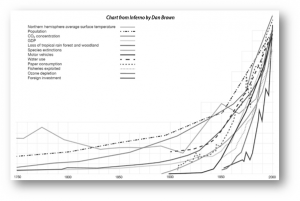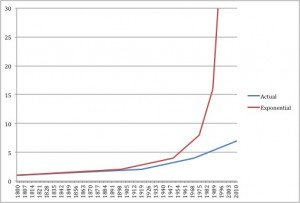On the issue of population: Brown vs. Reality
One major social issue Brown tackles in his novel, Inferno, is overpopulation. The antagonist in his novel, the genius scientist Dr. Zobrist, has created a genetically modified virus to fight overpopulation by making one third of the populace infertile. His reasoning for his mass sterilization plan is the claim that the population is growing exponentially and will continue to do so unless drastic measures are undertaken. “Any environmental biologist or statistician will tell you that humankind’s best chance of long-term survival occurs with a global population of around four billion” (Brown 105); consequently, Zobrist’s virus becomes a viable and necessary solution. Brown also presents graphs to illustrate Zobrist’s thesis and one of his other main characters, Sienna, characterized as highly intelligent and educated, agrees with Zobrist’s statements about population growth. But does Brown paint an accurate, non-apocalyptic picture? It is important to examine the assertion, because at the beginning of his novel he states the following: “All artwork, literature, science, and historical references in this novel are real.” (Brown 3) This might potentially lead millions of his readers across the globe to believe Brown’s portrayal of population growth to be actual fact. However, when examining the data on population growth in the past decades and projections for the future, it becomes clear that Brown gives an inaccurate account of the growth rate and oversimplifies its context, effects and solutions.
First, we need to compare the presented population growth in Inferno to scientific findings. Brown’s character Zobrist uses the concept of folding a sheet of paper multiple times as an example of geometric progression, where the thickness doubles every time you fold the paper, as a version of exponential growth in order to make his point that “the earth’s population, like our stack of paper, had very meager beginnings…but alarming potential” (Brown 101) and that “without drastic measures, exponential mathematics will become your new God” (Brown 104). To illustrate this, Zobrist or more accurately, Brown, also presents two graphs depicting population growth, which can be seen below (Figures 1 and 2). It should also be noted that in Inferno this graph is given its origin of being “published by the WHO the previous year delineating key environmental issues deemed by the WHO to have the greatest impact on global health” (Brown 138), although it actually comes from an article from New Scientist titled: “Special Report: How Our Economy Is Killing the Earth”. Brown does cite it correctly in the copyright page of his novel, but gives it a completely different background and purpose in the context of the novel, possibly misleading the lay reader.
(Figures 1 and 2. The graphs Brown presents on pages 138 and 103, respectively.)
Additionally, Brown’s character Sienna also affirms that “population growth is an exponential progression” (Brown 215).
In reality, however, population growth only ever showcased exponential growth during the beginning and middle of the 20th century. Zobrist himself actually states this when he lectures that “it took the earth’s population thousands of years to reach one billion people . . . it took only about a hundred years to double the population . . . in the 1920s (and) a mere fifty years . . . to double again (and) we’re well on track to reach eight billion very soon” (Brown 101). As depicted in the following simple graph (Figure 3), the slope of this described growth is only similar to exponential growth until about the 1970s. It then becomes far less severe.
(Figure 3. The actual growth as correctly depicted by Zobrist and exponential growth)
And furthermore the precise data gathered by the United Nations and others shows that, in fact, the period between 1950 and 1970 did suggest mathematical exponential growth. However, since the 1970’s the fertility rate and growth rate of the world’s population has been continually declining and is no longer in line with exponential growth (Bermingham 313-315). According to projections by the UN the world population will peak at 8.9 billion in 2050 and slowly decline from there as growth even “in the less developed regions is expected to slow down in the future (as) the (annual) growth rate of 1.6 per cent (for 1995-2000) will be halved in a little over 25 years and will be roughly halved again by mid-century” (World Population to 2300 5). Zobrist and Sienna’s view, therefore, is not actually in line with current scientific understanding, but rather a portrayal of a view found in Professor Paul Ehrlich’s The Population Bomb from 1968 where such exponential growth is said to continue. Looking even further back, to 1798, their view is in line with the thesis of an exponential population growth stated and consequently discussed by Thomas Malthus in his An Essay of the Principle of Population. One can clearly see that the fear and concept of exponential population growth is not a current scientific view a genius scientist such as Zobrist would hold today.
Next, we need to examine carefully the concept of overpopulation, which does not necessarily rely on population growth being exponential. Zobrist states that if population growth is left unchecked “the human race will not survive another century” (Inferno. 177.). Again, Brown has Sienna agree with her mentor Zobrist: “Speaking from a purely scientific standpoint (…) without some kind of drastic change, the end of our species is coming,” because “population growth is an exponential progression occurring within a system of finite space and limited resources” (Brown 215). Moreover, as already mentioned earlier, Zobrist also postulates, “that humankind’s best chance of long-term survival occurs with a global population of around four billion” and that “by any biological gauge, our species has exceeded our sustainable numbers” (Brown 105, 102). Is overpopulation indeed a problem we face today or will it become one in the future?
This is an issue far more controversial and there are scholars that go as far as to say that the world is not overpopulated nor will it be overpopulated in the near future and others claim that global population should not be larger than 1 billion. (Ryberg 413.)
So there is not a consensus that the best possible population size is 4 billion, as Zobrist asserts. But what can be said about overpopulation nonetheless? Ryberg lays the groundwork for the concept of an optimum population as follows: “With regard to the moral values which we think should be promoted, there is/are one (or some) population size(s) which is/are, under a set of circumstances, preferable” (Ryberg 413). As can be deducted from this, it becomes clear why overpopulation is such a controversial issue: different people have different moral values or standards and there are a set of circumstances which are not given and can also change over time. For example, the average living standard that one person might think is moral, but another might disagree with, may be related to population size in general or in relation to food availability, living space, wages, access to education, etc. And this may also change as technology advances and opens up new possibilities. In fact for precisely this reason, many believe that the concept of overpopulation is a myth, because “inventions of new technologies may make it possible to substitute for, what is at one time, a scarce resource with other less scarce resources. Agricultural improvements may increase food production. Shortage in energy resources may be surmounted by technological process” (Ryberg 416). This can be demonstrated by comparing the living standards of a western and densely populated city, such as Tokyo, to a less populated region in a developing country. Although far more people live in Tokyo the living standard is higher due to technological and other advantages. Thus, the case can be made that at the very least the concept of overpopulation cannot be reduced to the mere amount of people, but is a far more complex issue.
But say the world is in fact overpopulated or will be at some point in the years to come; is the only solution to fight this a plague killing half the population or a virus sterilizing a third of it? In Zobrist’s view this is the case as any indirect measures would be “like swinging a flyswatter at an incoming asteroid” (Brown 104). Although Brown ignores every indirect measure apart from bringing birth control to Africa (Brown 104), Zobrist’s seemingly absurd perception of the solutions can be found among acclaimed scientists, such as Garrett Hardin, who wrote: “How can we help a foreign country escape overpopulation? Clearly the worst thing we can do is send food . . . Atom bombs would be kinder” (Shrivastava 2032). To them the only plausible solutions are actions, which directly influence the population size or growth.
However, non Neo-Malthusian scientists have pointed out data that shows how indirect actions can greatly influence population growth. Two determinant factors are economic wellbeing and non-patriarchal societal structures. Barry Commoner has asserted that the “poor would reduce the number of desired children if and when they find adequate socio-economic opportunities” which can be achieved through “better health facilities (which would induce a reduction in the birth rate by reducing infant mortality), educational opportunities for women, and better employment opportunities for all” (Shrivastava 2035). This can be shown when looking at developed countries where growth rates have been shrinking since the 1950’s and continue to do so. This coincides with patriarchal structures falling apart and general economic growth in these regions since World War II. Women gained many rights, joined the work force, and generally became more independent. Additionally, Betsy Hartmann has asserted: “Son preference, combined with high infant and child mortality rates, means that parents must have many children just to ensure that one or two of them survive” (Shrivastava 2036). Developing countries are also well on the way of this development, but it will take at least another 40 years until the rates drop to Western standards (World Population to 2300 4). Therefore, it shows that modernizing, educating, and investing in developing countries has great effects on population and is a far more humane and effective strategy. Because cutting the population in half or sterilizing a third of it will only be beneficial if the population doesn’t continue to grow to the same extent again. Hence, this is a non-sustainable and therefore inferior method, and surely not the only one.
Brown presents a one-sided, apocalyptic, oversimplified, misleading view of the topic at hand, while actively telling the reader that it is fact. Of course, a novelist writes fiction and is free to invent, as he or she wants. However, Brown intentionally directs his readers to believe that everything apart from the storyline is not fiction. This, I believe, not only shatters of his integrity as a novelist and teacher, but is also harmful to society. His works have been translated into eleven languages and millions of copies have been sold all around the world. While being imprecise or untruthful about artwork or secret societies may be unnecessary and should be criticized, being imprecise or untruthful about the science of social issues such as overpopulation is potentially very dangerous. As mentioned above, millions of people read Dan Brown. But how many have read the UN Population Report or other scientific writing on this issue? Issues like this need public discourse and awareness and Brown does not contribute to this but is rather counterproductive. Confronted with this Brown states: “If I’ve done my job, you close this book saying ‘Oh my God, what an enormous problem, and there is no simple solution, and I kind of see Zobrist’s point‘”. If he had actually done his job right, he would have either left out the ‘fact page’ at the beginning of Inferno or presented actual fact.
Works cited:
Brown, Dan. Inferno. London: Transworld, 2013. Print.
Bermingham, John “Population and Environment.” Exponential Population Growth and Doubling Times: Are They Dead or Merely Quiescent? 24.4 (2003). Print.
World Population to 2300. Rep. no. ST/ESA/SER.A/236. New York: United Nations, 2004. World Population to 2300. Web. 23 Oct. 2013. 5
Ryberg, Jesper. “The Argument from Overpopulation – Logical and Ethical Considerations.” Population and Environment: A Journal of Interdisciplinary Studies 19.5 (1998). Print.
Shrivastava, Aseem. “Overpopulation: The Great Red Herring?” Economic and Political Weekly 27.38 (1992): 2032-038. Print.


